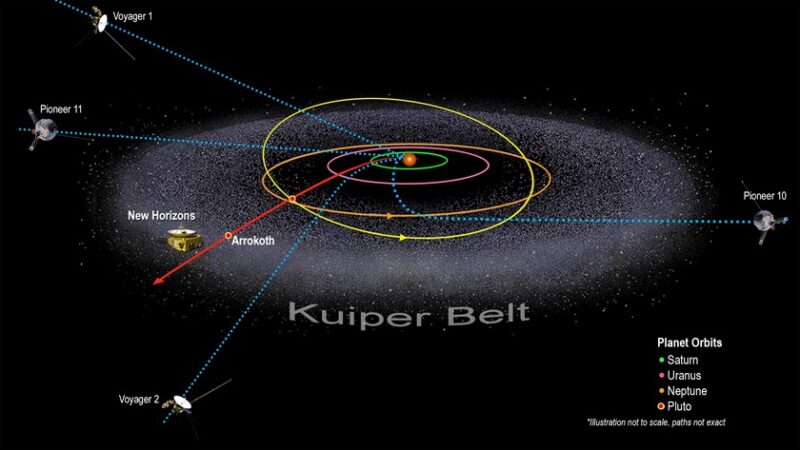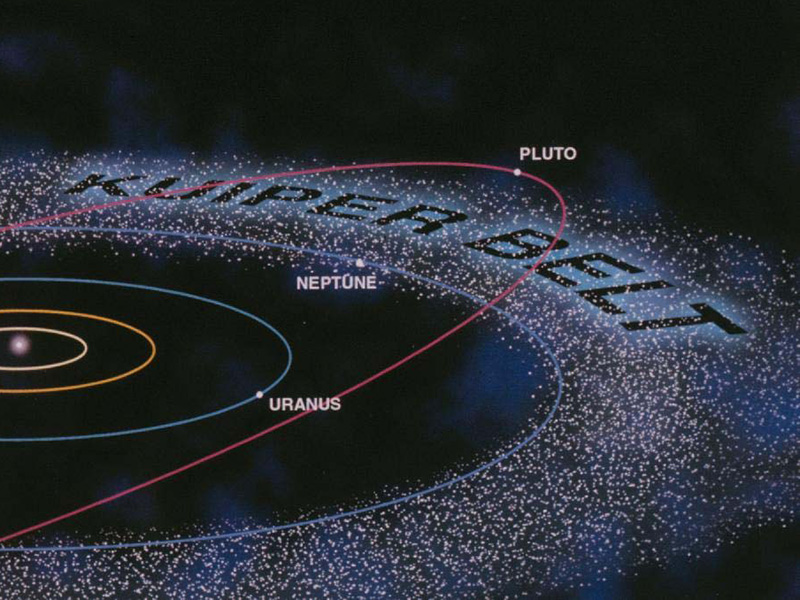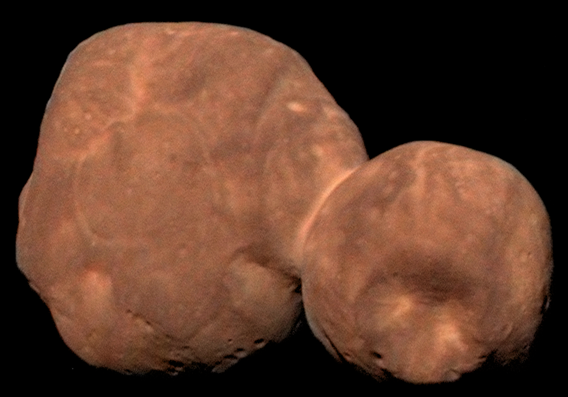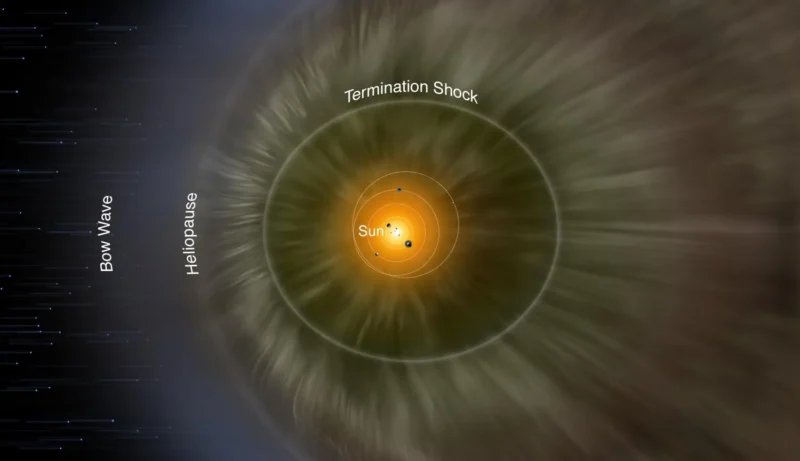
- The New Horizons spacecraft, launched in 2006, achieved historic flybys of Pluto in 2015 and Arrokoth in 2019, making it the fastest spacecraft ever sent from Earth.
- Chief scientist Alan Stern here provides an update, highlighting unexpected discoveries of dust impacts, an extended Kuiper Belt or even a second one, and outlines plans for future exploration.
- Its long-term mission goals include reaching the heliosphere’s termination shock and venturing into interstellar space, using its modern instrumentation to complement the findings of NASA’s Voyager spacecraft.
New Horizons visited Pluto in 2015
Remember how exciting it was when the New Horizons spacecraft encountered Pluto? This craft – the fastest one ever sent outward from Earth – launched on January 19, 2006, passed the moon’s orbit in just 9 hours, and then spent 10 years crossing the 3-billion-mile distance to Pluto. It swept past Pluto in 2015, passing within about 7,750 miles (12,500 km) of the little world and discovering, among many other things, a large, young, heart-shaped region of ice on Pluto plus mountains made of water ice. In 2019, New Horizons swept past Arrokoth, which thereby became the farthest and most primitive object in our solar system ever to be visited by a spacecraft. On April 4, 2024, New Horizons chief scientist Alan Stern provided an update of the mission’s findings, as it continues to move outward. He said New Horizons has found evidence for a 2nd Kuiper Belt.He also said the New Horizons team is still hopeful that groundbased searches will reveal new Kuiper Belt Objects that the spacecraft might be able to explore. He reported:
The spacecraft continues to collect round-the-clock data on our sun’s cocoon in the galaxy, called the heliosphere, and transmit that data, as well as the final data from our flyby of Kuiper Belt object Arrokoth, back to Earth … The first of those was the publication of exciting new results from our onboard dust counter instrument, which you can find online. It shows that over the past few years, the instrument detected an unexpectedly high number of dust impacts.
Why is that so exciting? Because it indicates more dust at greater distances from the sun than expected, which in turn could be evidence of an extended Kuiper Belt, or even a second Kuiper Belt, lying ahead.
Join us in our mission to educate and inspire people about the universe. Your donation can make a difference in astronomy and contribute to our growth and sustainability.

More Kuiper Belt Objects ahead?
So New Horizons is finding more dust than it expected in the far outer reaches of our solar system. And Alan Stern explained that there are other possibilities for the high dust-impact rate in this part of the solar system.
But, he said, the New Horizons team is also using groundbased telescopes to search along the spacecraft’s outbound trajectory for additional Kuiper Belt Objects. If any lie near the spacecraft’s path, perhaps it will be possible to study them. And he said those searches have led to:
… a surprising number of very distant KBOs ahead of us. That leads to a similar conclusion that the Kuiper Belt could be more extended, or even that there could be a 2nd Kuiper Belt, still farther ahead. These new groundbased results have been submitted for scientific peer review but aren’t yet published. However, a summary of them is posted here and here.
Together, these results have ignited renewed interest in the possibility of finding a distant KBO that New Horizons could fly past in the late 2020s or even 2030s. Toward that end, our team has proposed a multiyear KBO flyby target search to NASA.
If approved by NASA, that effort would initially continue the deep, groundbased KBO searches with the Japanese Subaru Telescope we’ve been using, but with more search time and a deeper search enabled by a new, high-throughput filter that the New Horizons project provided to Subaru.
Beginning in 2025 …
Then, beginning in 2025, we plan to propose to use the even more capable Vera Rubin Observatory (VRO), which is jointly funded by the National Science Foundation and the U.S. Department of Energy, for this search. VRO is a new observatory scheduled to come online in late 2024, and can search even more deeply than Subaru can.
Later, once NASA’s Roman Space Telescope is launched in 2027 or 2028, we would propose to employ this still even more capable observatory, also with custom machine-learning software and supercomputers to crunch those data.
Our calculations indicate that, given the evidence for an extended Kuiper Belt and very distant KBOs, that this triad of searches might just find New Horizons a second flyby KBO. But the calculations also show that even such a search is a longshot, looking for proverbial needles in the cosmic haystack, and might come up dry.

Nonetheless, he said …
We know that the odds of finding a new flyby target are much more remote without this newly envisioned set of searches. We also know that the scientific payoff of another KBO close flyby for planetary science in general are immense. And the New Horizons team is eager to search. We are willing to try everything humanly possible to get to another KBO flyby. If we do succeed, we’ll have hit the jackpot, and will have the ability to once again be firing our engines to intercept a KBO for close up study, just as we did to achieve the 2019 flyby of KBO Arrokoth — the first KBO ever examined by any spacecraft!
Also just ahead for New Horizons is our continuing studies of the Sun’s outer heliosphere, observing KBOs we pass in the distance, and making other scientific measurements that only a spacecraft in the distant Kuiper Belt can make.
New Horizons is in excellent health, and has sufficient fuel and power to continue to explore into the 2040s, at least. By the late 2020s or 2030s, the spacecraft should fly through the heliosphere’s so-called termination shock, which is the precursor to the heliopause and our entry into interstellar space! NASA’s venerable Voyager spacecraft have already studied the termination shock, the heliopause and interstellar space, but New Horizons has more modern sensors aboard, to greatly supplement what the Voyagers could do.
How can New Horizons keep exploring?
Stern concluded:
To make all this possible, as our spacecraft’s nuclear battery produces less and less power each year, we plan to uplink new software. That software package is called autonomy and fault protection, and the team is already designing and coding it. After extensive testing, we expect to transmit it to New Horizons using NASA’s Deep Space Network of communications antennas. You can learn more about the Deep Space Network.
I’m excited about all of these plans for New Horizons. I’m also excited for us to continue to making scientific discoveries in data we’ve already acquired and the data we’ll collect in 2024. Nearly two-dozen scientific papers with such results, ranging from Kuiper Belt and KBO studies, to heliospheric science, and more, were published in 2023, and a similar number is planned for this year.
Ways to follow New Horizons news and commentary
NASA’s New Horizons website
New Horizons mission website
New Horizons on Facebook
New Horizons eNews signup

Bottom line: News from the Pluto spacecraft New Horizons. It is still alive and still speeding outward. It has recently found evidence for a 2nd Kuiper Belt. The team is hopeful new spacecraft targets will be found.
Via Alan Stern, New Horizons